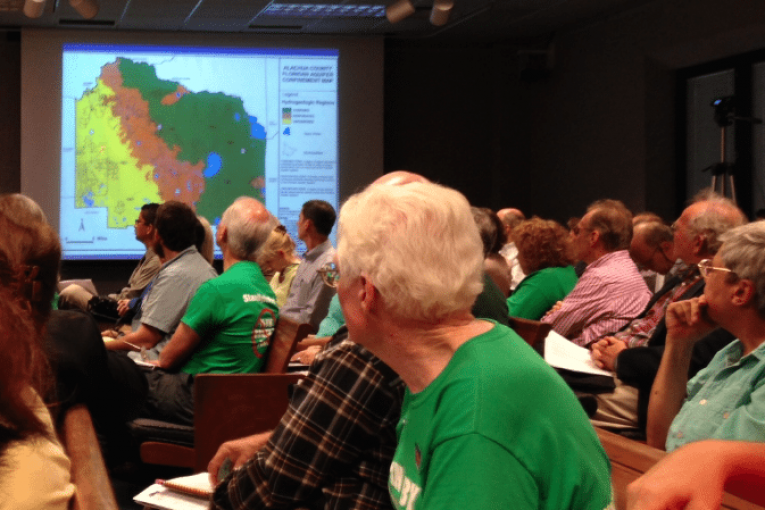
At a special workshop on Sept. 16, Alachua County staff presented more information to further reinforce its recommendation to deny Plum Creek’s sector plan, this time on the topic of environmental impacts.
Chris Bird, director of the Alachua County Environmental Department, said the development proposal by forestry company Plum Creek has generated dialogue across the community.
“The proposal and the environmental outreach effort have inspired people’s hopes and dreams,” he said.
But along with the enthusiasm generated by the project, he said it’s important to “talk not only about benefits but costs, and environmental costs.”
“Our job is to tell it like it is,” he said. “It is not our job to tell it how we would like it to be. We have to give you our best technical…evaluation.”
Michael Drummond, senior environmental planner for the county, said the two areas in which Plum Creek is proposing the densest development are also wetlands with high risks of flooding.
He noted that Plum Creek is proposing to not follow the county’s current land development code protection for wetlands. They are proposing to only be subject to state and federal protections, and “the state and federal protections for wetlands are not as stringent as the county’s,” Drummond said.
Under its proposal, Plum Creek would also be subject to only state and federal regulations for roads, utilities and rail spurs.
Drummond also noted that the county mandates that drainage areas to compensate for development on floodplains must be installed within a certain distance to where the development occurred. The Plum Creek proposal, he said, is to allow that compensation to take place anywhere within its thousands of acres.
Steve Hofstetter, the county’s environmental program supervisor, displayed a map of wildlife corridors — areas where animals are known to use for traveling through the county. On the map, the most-used corridors formed a dark green arc running north/south through the eastern third of the county. Hofstetter noted that it cuts through area where Plum Creek is proposing its most intensive development.
He said Plum Creek’s proposed alternative wildlife corridor doesn’t have some key features. It is not very wide and allows intensive development right up to the corridor boundary.
“It ends right at the intersection of the interstate – very difficult for anything to cross on foot,” he said. “We believe it lacks some of the connectivity we’re looking for.”
Robin Hallbourg, a professional geologist and a county water resources staff member, said the Plum Creek proposal also lacks clear measures to enforce water quality.
“Specific policies were not proposed to protect water quality,” she said. “There were no policies proposed for springs protection in the submitted plan.”
During a public comment section, about 45 residents spoke.
Resident Rob Brinkman said that if subdivisions with high water consumption patterns continue to pop up — especially on the county’s west side — the area’s water resources will be quickly depleted. He praised Plum Creek’s deed-restricted residential property plans that don’t allow watering of lawns.
“We can stand by our plan, and we will run out of water,” he said, playing off of Plum Creek opponents’ campaign slogan.
Jean Caulderwood, a former City of Alachua mayor and commissioner, stood up to advocate a balance in maintaining natural resources and letting property owner develop their land.
“I don’t think it does this process any good to paint Plum Creek as a greedy corporate developer,” she said. “Nor does it do any good to paint the county commission as someone who wants to hammer economic development.”
She said she does support the Plum Creek plan and thinks a satisfying agreement between the landowner and the county can be struck.
She pointed to Alachua’s Progress Park as an example of balancing development with agricultural and environmental concerns.
“You’ll see hay bales sitting in the front lot,” she said. “You can compromise and maintain a balance between your corporate development and your natural resources.”




